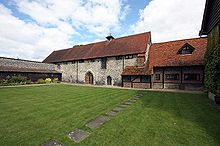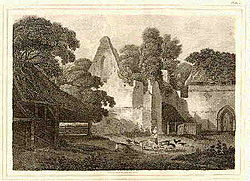- Burnham Abbey
-
Burnham Abbey was founded as a house of Augustinian nuns in 1266 by Richard, 1st Earl of Cornwall, King of the Romans, who presented the community with the surrounding lands and the parish church of Burnham in Buckinghamshire. The community consisted of around twenty nuns at the outset, but was never especially wealthy and by the time of the dissolution there were only ten.
History
A complaint was made shortly after the foundation that Richard had diverted a watercourse to the abbey that had been used by a nearby village and that he also had given 20 acres (81,000 m2) of common land to the monastery. It is unknown as to whether this issue was resolved.
In 1311 a nun, Margery of Hedsor, left the monastery and her vows and was subsequently excommunicated. This sentence was renewed periodically for some years until it was cancelled by the Bishop for reasons unknown. A serious legal dispute occurred in 1330. This was concerning the ownership of the manor of Bulstrode, which had been granted to the abbey but was claimed by a Geoffrey de Bulstrode, who in protest proceeded to vandalise the property and harass the servants of the abbess. Eventually a commission found in favour of the abbey but by then, substantial losses had been accrued.
Being of little wealth, Burnham Abbey should have been closed in the first wave of the dissolution in 1536, but a petition by local commissioners saved the monastery until its final end in 1539 after which it was leased to William Tyldesley. The church was demolished in about 1570 and a house formed from much of the remaining buildings. By 1719, it was a farm with some of the buildings such as the refectory having become ruinous. In 1913 it was purchased by Lawrence Bissley who restored the remaining buildings and converted the original chapter house into a chapel. In 1916 a community of Anglican Augustinian nuns took possession and began to further restore and extend the abbey for their own use.
References
- 'House of Austin nuns: The abbey of Burnham', A History of the County of Buckingham: Volume 1 (1905), pp. 382-84.
- Anthony New. 'A Guide to the Abbeys of England And Wales', p88-90. Constable.
Categories:- Churches in Buckinghamshire
- Grade I listed buildings in Buckinghamshire
- Grade I listed monasteries
- History of Buckinghamshire
- Monasteries in Buckinghamshire
- Augustinian nunneries in England
- 1266 establishments
- Religious organizations established in the 1260s
Wikimedia Foundation. 2010.


